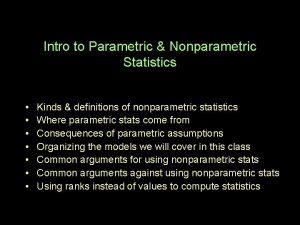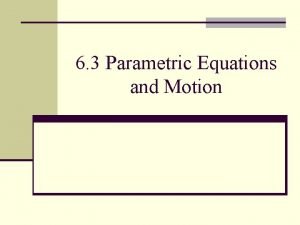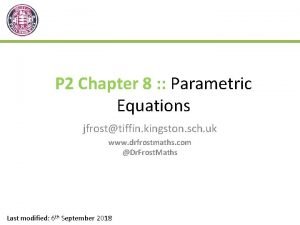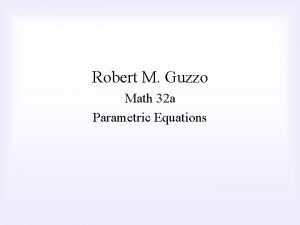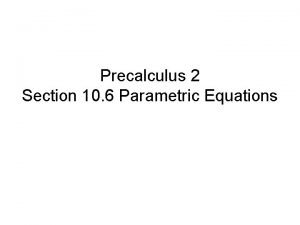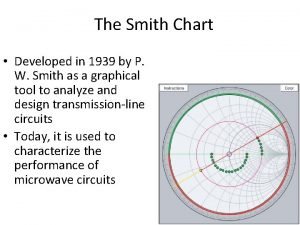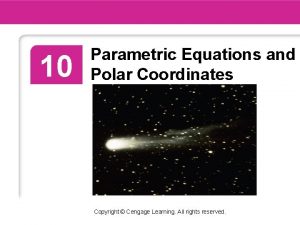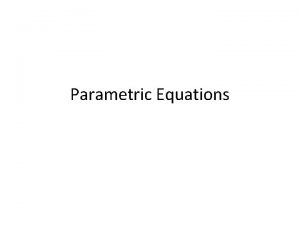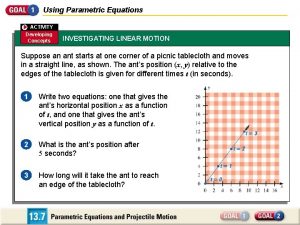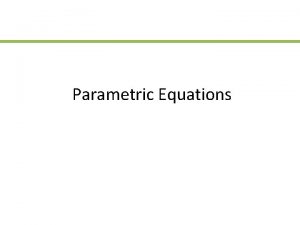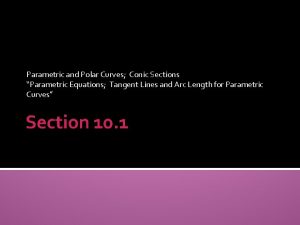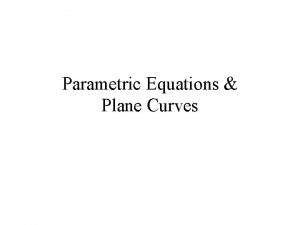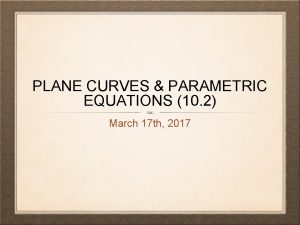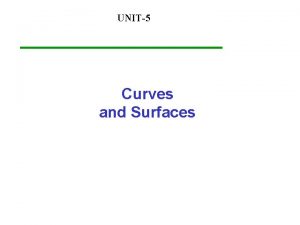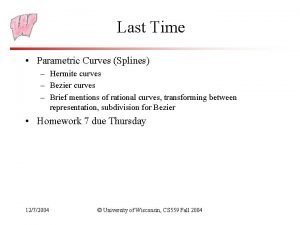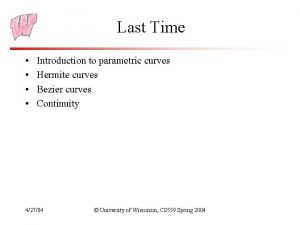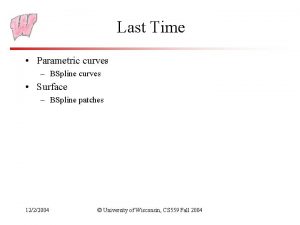Parametric Equations Plane Curves Parametric Equations Let x















- Slides: 15

Parametric Equations Plane Curves

Parametric Equations • Let x = f(t) and g(t), where f and g are two functions whose common domain is some interval I. The collection of points defined by • (x, y) = (f(t), g(t)) • is called a plane curve.

Parametric Equations • The equations • x = f(t) y = g(t) • where t is in I, are called parametric equations of the curve. The variable t is called a parameter.

Parametric Equations • Parametric equations are used to describe movement along a curve. • Arrows are drawn along the curve in order to show direction or orientation along the curve as t varies from a to b.

Discussing a Curve • Discuss the curve defined by the parametric equations • x = 3 t 2 y = 2 t • -2 ≤ t ≤ 2

Graphing Parametric Equations Using a Graphing Calculator • 1. Set the mode to PARametric. • 2. Enter x(t) and y(t). • 3. Select the viewing window. In addition to setting Xmin, Xmax, Xscl, and so on, the viewing window in parametric mode requires values for the parameter t and an increment setting for t (Tstep) • 4. Graph

Graphing Parametric Equations Using a Graphing Calculator • Graph • x = 2 cos t • 0≤t≤p y = 3 sin t

Finding the Rectangular Equation of a Curve • Find the rectangular equation of the curve whose parametric equations are • x = a cos t y = a sin t • where a > 0 is a constant.

Finding the Rectangular Equation of a Curve • When given trig functions, we use the identity • cos 2 t + sin 2 t = 1 • (x/a)2 + (y/a)2 = 1 • x 2 + y 2 = a 2 • As the parameter t increases, the corresponding points are traced in a counterclockwise direction around the circle.

Finding the Rectangular Equation of a Curve • If the function is not a trig function: • 1. Solve both equations for t • 2. Set the two equations equal to each other (transitive property of equality) • 3. Solve for y.

Projectile Motion • We can use parametric equations to describe the motion of an object (curvilinear motion). • When an object is propelled upward at an inclination q to the horizontal with initial speed v 0, the resulting motion is called projectile motion.

Projectile Motion • • Parametric equations of a projectile: x = (v 0 cos q)t y = -½gt 2 + (v 0 sin q)t + h where t is the time and g is the constant acceleration due to gravity (32 ft/sec 2 or 9. 8 m/sec 2).

Projectile Motion • Examples p. 724 and 725. • Talladega 500 example

Finding Parametric Equations • Find parametric equations for the equation: • y = x 2 – 4 • Remember there are two equations. • Let x = t • y = t 2 – 4 (Yes it is that easy)

 Parametric vs non parametric test
Parametric vs non parametric test Bmk+
Bmk+ Parametric test
Parametric test Parametric and non parametric algorithms
Parametric and non parametric algorithms John 10:22-28
John 10:22-28 Data plane control plane and management plane
Data plane control plane and management plane Parametric equations of motion
Parametric equations of motion Chapter 7 conic sections and parametric equations
Chapter 7 conic sections and parametric equations Dr frost parametric equations
Dr frost parametric equations Parametric equations word problems
Parametric equations word problems How to solve parametric equations
How to solve parametric equations How to solve parametric equations
How to solve parametric equations Complete smith chart
Complete smith chart Parametric equations and polar coordinates
Parametric equations and polar coordinates Parametric equations
Parametric equations How to solve parametric equations
How to solve parametric equations
